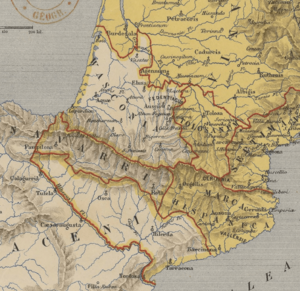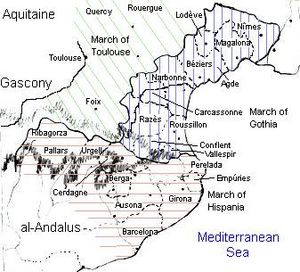Spanish March facts for kids
The Spanish March was a special border area created by a powerful king named Charlemagne in 795. It was like a protective shield between his Frankish Empire and the Muslim lands of Al-Andalus (which is now Spain).
This area was a military buffer zone, meaning it was a neutral or friendly territory that helped keep two powerful groups from fighting directly. Over time, the different parts of the Spanish March slowly became more independent from the Frankish Empire. Eventually, many of these areas joined together to form what is now Catalonia.
Contents
Where Was the Spanish March?
The Spanish March was mostly in the eastern part of the Pyrenees mountains, stretching towards the Ebro River. The people living there were a mix of different groups. There were Basques in the northwest, Jews, and many Hispano-Romans (people with Roman and Visigothic roots).
These people were influenced by the culture of Al-Andalus, the Muslim-ruled lands. However, after the Franks conquered the area in 759, many towns and areas started to support the Frankish kings. New forts were built to protect the borders.
The size and shape of the Spanish March changed a lot. This happened because of wars between empires and the goals of local rulers, called counts or governors. Over time, the people and rulers of the March became more independent. Many small areas, or counties, eventually formed the Principality of Catalonia, with Barcelona as its main center.
Some of the counties that were part of the March included:
- Ribagorza
- Urgell
- Cerdanya
- Empúries
- Besalú
- Osona
- Barcelona
- Girona
- Conflent
- Roussillon
- Vallespir
How the Spanish March Started
The Spanish March came about because the Frankish kingdom, led by kings like Charles Martel and Charlemagne, wanted to expand south. They fought against the Muslim rulers from the Iberian Peninsula for many years.
Muslim forces had conquered much of the Iberian Peninsula and reached the Pyrenees mountains. In 719, they took over a region called Septimania and set up a strong base in Narbonne. They offered good deals to the local people, sometimes even marrying into ruling families, to secure their control.
However, the Muslim expansion was stopped in 721 at the Battle of Toulouse. Even so, Muslim forces continued to raid areas to the north. In 730, a peace treaty was signed between the Duke of Aquitaine and a Berber rebel leader in Cerdanya. But this peace did not last long.
The region of Aquitaine (which included the Duchy of Vasconia) promised loyalty to the Frankish leaders several times but remained mostly independent. After many years of fighting, the Frankish king Pepin the Short finally conquered Septimania in 759. He then spent eight years crushing the independence of Aquitaine.
Pepin's son, Charlemagne, continued this work. He wanted to create a strong border area to protect his empire from the Muslim rulers in Iberia. He also made sure the Duchy of Vasconia was under his control by creating the Kingdom of Aquitaine, ruled by his son Louis the Pious in 781.
Creating the Border Zone
The Franks created the Spanish March by taking over lands that used to be part of the Visigothic Kingdom. These lands had been conquered by the Muslims.
Here's how some areas were added:
- Around 760: Roussillon (with Vallespir) was conquered.
- 785: The county of Girona (with Besalú) was taken.
- Around 790: Ribagorza and Pallars were linked to Toulouse and added.
- 798: Urgell and Cerdanya were added.
- Before 800 (first records in 812): Empúries (with Perelada) came under Frankish control.
After more battles, the important County of Barcelona (with Osona) was captured by Frankish forces in 801. Many castles were built in Aragon between 798 and 802. Frankish rule also spread to the upper Ebro river and Pamplona.
When Charlemagne died in 814, there were some rebellions. Pamplona, led by a local Basque lord, broke away from the Spanish March. The County of Aragon also became independent around 820. The remaining Catalan counties then became a natural extension of the March of Gothia, ruled by local leaders under the Frankish Empire.
How the March Was Organized
The people in the Spanish March were mainly Basques and Hispano-Romans. There were also Muslims and Jews. These groups helped repopulate the areas that the Franks had conquered. The region's control changed often, depending on the power of the empires and the goals of the counts who ruled the counties.
As the Frankish Empire's power became weaker, the rulers of the Spanish March became more independent. This region later became part of Catalonia.
Louis the Pious, Charlemagne's son, captured Barcelona from its Muslim ruler in 801. This made Frankish power strong in the borderland. The Counts of Barcelona then became the main representatives of Frankish authority in the Spanish March. The March included many smaller areas, each ruled by a lesser knight with his soldiers. These knights were supposed to be loyal to the Count, and through him, to the Emperor.
The rulers were called "counts." If they governed several counties, they were sometimes called "duke." If their county was on the border with the Muslim kingdom, they might be called "marquis." These titles showed their importance and role in defending the frontier.
In the early 800s, Charlemagne started a new way of granting land called aprisio. This involved giving land that was empty or abandoned to settlers. These grants came with special rights and freedoms, giving the settlers a lot of independence from the central government. This system helped encourage people to move to the border region and provide armed men to defend the Frankish frontier.
However, poor communication and the distance from the central Frankish power allowed local leaders to become very strong. These areas were often self-sufficient and focused on farming. Each was ruled by a small group of military leaders who passed their power down through their families.
For example, the first Count of Barcelona, Bera, was appointed by the King in 801. But later, strong heirs of counts were able to inherit the title. This became a custom until the countship became hereditary (passed down in families) by 897. The County of Barcelona became truly independent under Count Borrell II. This happened when the kings of France failed to help him defend the County against a powerful Muslim leader.
The early history of Andorra is a good example of a small area in the region. Andorra is the only part of the Spanish March that was never fully taken over by either France or Spain. This is even mentioned in its national anthem!
See also
 In Spanish: Marca Hispánica para niños
In Spanish: Marca Hispánica para niños



